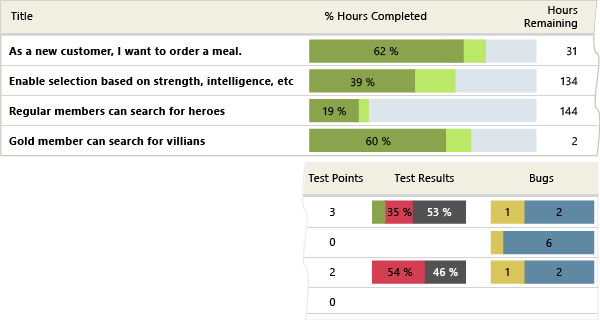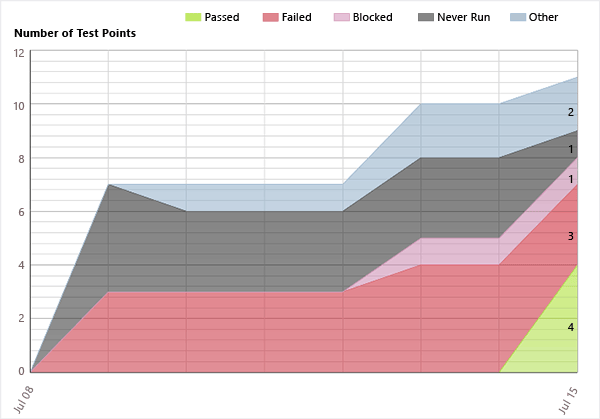By adding a report server to your TFS (on-premises) deployment, you can access a wealth of data about your team's projects, such as build quality, bug trends, burndown, and test progress. SQL Server Reporting Services (SSRS) reports provide insight to help teams manage work and improve processes.
 Add a report server |  Upload reports |  Grant permissions to view or create reports | 
|
Now that you've uploaded reports, how do you use them to track progress, gain insight, and improve processes?
First, make sure your team is performing the activities that create the data that these reports use. Your team is probably performing most of these activities already.
Here's a summary of the reports that TFS provides and the team activities that are associated with them. Over time, you can use these reports to see trends and identify which practices and processes require more attention to deliver desired results.
 Monitor code quality
Monitor code quality
Build reports track the quality of software under development. By defining tests to run automatically as part of each build definition and instrumenting tests to gather code coverage data, you can gain insight about the quality of the builds, tests, and code.
Build and test activities
| Build reports
|
For a free downloadable guide to testing and monitoring builds, see Testing for Continuous Delivery with Visual Studio 2012.
Sample build success over time report

 Monitor progress
Monitor progress
Project management reports provide insight into how much work the team is tackling within a sprint or release, and the rate of their progress. By linking work items and updating specific fields as work is performed, you can track the progress of individual stories and be able to more accurately estimate future activities.
Work item tracking activities
| Project management (Scrum) reports
Project management (Agile and CMMI) reports
|
Sample stories overview report

 Monitor test plans and bug tracking
Monitor test plans and bug tracking
Test planning reports support monitoring the test progress and coverage of backlog items or user stories. Bug tracking reports illustrate the team's capacity to find and resolve bugs.
Test planning and bug tracking activities
| Test and bug reports
|
Sample test plan progress report

 Q & A
Q & A
 Q: Do reports handle stories and substories or tasks and subtasks?
Q: Do reports handle stories and substories or tasks and subtasks?
A: Yes, you can subdivide stories or backlog items as well as tasks, creating a nested hierarchy of both backlog items and tasks. You can nest items several levels deep. If you subdivide a task into subtasks, specify hours only for the subtasks. These hours are rolled up as summary values for the parent task and their parent backlog item. To correct reports you believe are in error, see Address inaccuracies published for summary values.
 Q: Which reports depend on linking work items?
Q: Which reports depend on linking work items?
A: The overview and progress reports depend on linking tasks, test cases, and bugs to backlog items. You must link these items using the parent-child link for tasks and bugs and the Tested By link for test cases.
 Q: Which reports depend on Microsoft Test Manager?
Q: Which reports depend on Microsoft Test Manager?
A: Test Case Readiness and Test Plan Progress reports are designed to work with Test Manager. Also, the test points and test progress in project management overview reports depend on linking test cases to backlog items.
 Q: Are these reports the same as the agile planning charts that appear in Team Web Access (TWA)?
Q: Are these reports the same as the agile planning charts that appear in Team Web Access (TWA)?
A: While some reports do display similar information, such as sprint burndown and velocity or status on all iterations, these reports are formatted differently and support additional filters. Other reports, such as the build and test planning reports, are not available through TWA at this time.
 Q: Do you want to create additional product areas or release milestones?
Q: Do you want to create additional product areas or release milestones?
A: See Create areas or iterations.
 Q: Do you want to bulk edit work items to assign them to an area, iteration, team member, or priority?
Q: Do you want to bulk edit work items to assign them to an area, iteration, team member, or priority?
A: See Bulk modify work items.
 Q: Do you want to add a field to track additional data?
Q: Do you want to add a field to track additional data?
A: See Add or modify a work item field to support reporting.
 Tip
Tip